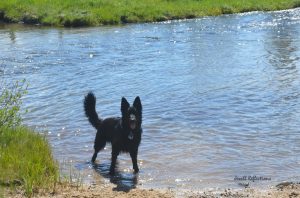
BY FRAN JEWELL

Our hearts go out to the dog that is shy or even fearful about life. We are drawn to the dog in the back of the kennel at the shelter that appears to have had a rough life and is afraid to even come visit you. We instinctually want to nurture this dog back to a happy dog. Or we are drawn to the puppy that crawls into your lap seeking shelter from the other puppies. As humans, we have big hearts and want nothing more than to help.
What is hard for us with healing hearts to fathom is that studies are now showing that temperament is genetic. So, when we see the fearful dog, in the past we assumed this little guy had been through some trauma or abuse. But, the reality is that most dogs with solid temperaments can be horribly abused and still come out with happy tails.
The key evaluation for any dog that displays fearful behavior is recovery. How fast can a dog recover from a scary event? Within minutes? Hours? Days? Months? The longer the recovery time, the more likely the fear cannot be conquered.
There are other factors, as well. How we treat our fearful dog is paramount. If we nurture dependence and coddle the fear, our dog will more than likely sink into deeper fear. Dogs are literalists. If you pet the fear, this dog will see that as reward for that behavior. The dangerous part is that a fearful dog that is dependent upon its owner is most likely to become possessive of its owner. With possessiveness comes aggression. Even a fearful dog that initially retreats when afraid can very likely start using his natural instincts to guard what he thinks is his.
When you consider taking a fearful dog into your life, one of the biggest questions you should ask yourself is, “Am I a natural leader? Or am I a softie?” If you are a softie, you must then ask yourself, “Am I willing to learn how to be a leader?”
Leadership, or providing guidance and boundaries, is the only way that a fearful dog can learn to cope with fearful situations. As an example, a good leader will give their fearful dog a job to do in the face of that fearful situation. Instead of coddling him and petting him, telling him it’s all right, a good leader will refocus the dog and tell him what he should be doing.
A leader acts like a leader all day. Treating a fearful dog like a baby or a human is truly a death sentence for this dog. Controlling food, sleeping space, resources and possessions, height, and yes, even affection, is a must to help a fearful dog become self-confident. I did not say control love!
It is a ballet to be compassionate, loving, and yet directive and firm in boundaries. If you have a fearful or shy dog in your life, to truly help him cope, leadership is the kindest and most humane thing you can do for your dog.
Fran Jewell is an Idaho Press Club award-winning columnist, IAABC-certified dog behavior consultant, NADOI-certified instructor #1096 and the owner of Positive Puppy Dog Training, LLC, in Sun Valley. For more information, visit positivepuppy.com or call (208) 578-1565.


